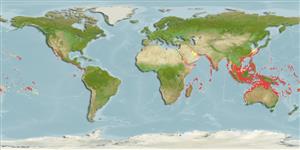>
Eupercaria/misc (Various families in series Eupercaria) >
Scaridae (Parrotfishes) > Scarinae
Etymology: Scarus: Greek, skaros = a fish described by anciente writers as a parrot fish; 1601 (Ref. 45335).
Environment: milieu / climate zone / depth range / distribution range
Ecologia
marinhas; estuarina associadas(os) a recifes; intervalo de profundidade 1 - 90 m (Ref. 89642). Tropical; 31°N - 35°S, 21°E - 77°W
Indo-Pacific: Persian Gulf (Ref. 80050); Red Sea and Algoa Bay, South Africa (Ref. 5490) to Rapa and Ducie islands, north to southern Japan, south to Perth, New South Wales. Likely at Seychelles (Ref. 1623). Eastern Pacific: Gulf of California to Ecuador (Ref. 5227). Eastern Mediterranean: off the coast of Shiqmona, first Lessepsian immigrant of Family Scaridae (Ref. 45081).
Length at first maturity / Tamanho / Peso / Idade
Maturity: Lm ?, range 49 - ? cm
Max length : 75.0 cm TL macho/indeterminado; (Ref. 90102); common length : 30.0 cm TL macho/indeterminado; (Ref. 55763); Idade máx. registada: 13 anos (Ref. 42001)
Espinhos dorsais (total): 9; Raios dorsais moles (total): 10; Espinhos anais 3; Raios anais moles: 9. This species is distinguished by the following characters: median predorsal scales 6-8 (usually 7); 3 scale rows on cheek, 1(6-7), 2(6-9), 3(3-5); pectoral-fin rays 13-15 (occasionally 15); terminal male usually with 2 conical teeth on side of upper dental plate (female without), with lips mainly covering the plates; caudal fin rounded in small female, with prolonged lobes in large adult. Colour of male dark reddish brown anteriorly with a bright green dot at top end of line from mouth through eye to top of opercular opening; female red on head, belly and fins, side with wavy black and white stripes, and dark green bands around the mouth and eye (Ref. 9793, 90102).
Adults inhabit lagoon and seaward reefs (Ref. 1602), in slopes and drop-offs (Ref. 48636), often solitary but may sometimes occur in small groups (Ref. 9710, 48636). Males common in atolls where they live mainly around the inner and outer edges of barrier reefs at depths of about 30 ft; females prefer deeper habitat (Ref. 4821). Small juveniles in groups are found inshore on algae reef habitat (Ref. 9710, 48636) and sometimes enter silty, murky environments (Ref. 5490). Feed by scraping algae from rocks and corals (Ref. 5227). Are protogynous hermaphrodites (Ref. 55367). Caught with nets and other types of artisanal gear. Marketed fresh (Ref. 5284). In the Hong Kong live fish markets (Ref. 27253). Minimum depth reported from Ref. 90102.
Life cycle and mating behavior
Maturidade | Reprodução | Desova | Ovos | Fecundidade | Larvas
Oviparous, distinct pairing during breeding (Ref. 205). Sex change occurs at 29.0 cm TL and 7 years of age (Ref. 55367).
Parenti, P. and J.E. Randall, 2000. An annotated checklist of the species of the labroid fish families Labridae and Scaridae. Ichthyol. Bull. J.L.B. Smith Inst. Ichthyol. (68):1-97. (Ref. 35918)
Categoria na Lista Vermelha da IUCN (Ref. 130435)
Ameaça para o homem
Harmless
Utilização humana
Pescarias: espécies comerciais; Aquário: Espécies comerciais
Mais informação
ReferênciasAquaculturaPerfil para aquaculturaEstirpesGenéticaElectrophoresesHereditariedadeDoençasProcessamentoNutrientsMass conversion
Ferramentas
Relatórios especiais
Descarregue XML
Fontes da internet
Estimates based on models
Preferred temperature (Ref.
123201): 24.5 - 29.1, mean 28 °C (based on 1802 cells).
Phylogenetic diversity index (Ref.
82804): PD
50 = 0.5000 [Uniqueness, from 0.5 = low to 2.0 = high].
Bayesian length-weight: a=0.01445 (0.01193 - 0.01751), b=3.03 (2.99 - 3.07), in cm total length, based on LWR estimates for this species (Ref.
93245).
Nível Trófico (Ref.
69278): 2.0 ±0.0 se; based on diet studies.
Resiliência (Ref.
120179): Médio, tempo mínimo de duplicação da população 1,4 - 4,4 anos (K=0.47; tmax=13).
Prior r = 0.55, 95% CL = 0.36 - 0.83, Based on 1 stock assessment.
Fishing Vulnerability (Ref.
59153): Moderate to high vulnerability (50 of 100).
Climate Vulnerability (Ref.
125649): High to very high vulnerability (74 of 100).
Nutrients (Ref.
124155): Calcium = 25 [14, 42] mg/100g; Iron = 0.629 [0.410, 0.980] mg/100g; Protein = 18.9 [16.8, 20.7] %; Omega3 = 0.0973 [, ] g/100g; Selenium = 25.9 [14.6, 41.5] μg/100g; VitaminA = 34 [10, 113] μg/100g; Zinc = 2.13 [1.50, 2.72] mg/100g (wet weight); based on
nutrient studies.
